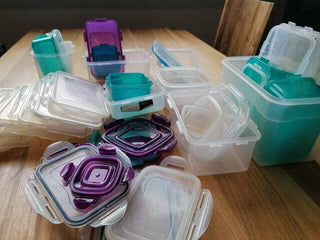When it comes to keeping your food fresh and safe, the material of your food storage containers is a critical decision. Two popular choices are polycarbonate and polypropylene, each with its own set of benefits and drawbacks. This blog post will dive into the differences between polycarbonate and polypropylene food storage, helping you make an informed decision for your kitchen needs.
Polycarbonate Food Storage
Polycarbonate is a type of plastic known for its strength and durability. It's often used in food storage containers because it can withstand high temperatures, making it suitable for microwave use and dishwasher safe. Polycarbonate containers are also clear, allowing you to easily see their contents, and are shatter-resistant, which is a significant advantage in busy kitchens.
Pros of Polycarbonate Containers:
- High clarity for easy identification of contents.
- Excellent durability and shatter resistance.
- Microwave and dishwasher safe.
Cons of Polycarbonate Containers:
- Can release BPA (Bisphenol A), a chemical that has raised health concerns, into food when heated.
- Typically more expensive than polypropylene containers.
Exploring Polypropylene Food Storage
Polypropylene, on the other hand, is a lighter plastic that is also known for its durability. It's a great choice for food storage because it does not contain BPA, making it a safer option for health-conscious individuals. Polypropylene containers can resist chemical leaching and are suitable for both hot and cold storage, although they may not be as clear as polycarbonate options.
Pros of Polypropylene Containers:
- BPA-free, reducing health risks.
- Good resistance to chemical leaching.
- Suitable for hot and cold storage.
- Generally less expensive than polycarbonate containers.
Cons of Polypropylene Containers:
- Not as clear as polycarbonate, making content identification harder.
- May not be as heat-resistant as polycarbonate, limiting use in microwaves and dishwashers.
Making the Right Choice for Your Kitchen
When choosing between polycarbonate and polypropylene food storage containers, consider your specific needs:
- Health and Safety: If avoiding chemicals like BPA is a priority, polypropylene is the better choice.
- Visibility and Durability: For a clearer view of contents and a more durable option, consider polycarbonate.
- Cost and Usage: If you're looking for a cost-effective solution and primarily store food at room temperature or in the fridge, polypropylene containers might suit your needs better.
Conclusion
Both polycarbonate and polypropylene offer unique advantages for food storage. By understanding the properties of each material, you can choose the right containers that fit your kitchen's demands. Whether you prioritize health and safety, durability, or cost, there's a food storage solution out there that's perfect for you. Keep these tips in mind, and ensure your food stays fresh and safe in the right type of container.
COME TO MR. SIGA TO GET YOUR FOOD CONTAINERS SOLUTION!

